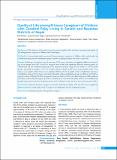Please use this identifier to cite or link to this item:
https://hdl.handle.net/20.500.14356/1465| Title: | Quality of Life among Primary Caregivers of Children with Cerebral Palsy Living in Sarlahi and Rautahat Districts of Nepal |
| Authors: | Pandit, Bina Singh, Jitendra Kumar Karn, Ananda Kumar Pandit, Rina |
| Citation: | PanditB., SinghJ. K., KarnA. K., & PanditR. (2021). Quality of Life among Primary Caregivers of Children with Cerebral Palsy Living in Sarlahi and Rautahat Districts of Nepal. Journal of Nepal Health Research Council, 18(4), 619-625. https://doi.org/10.33314/jnhrc.v18i4.2282 |
| Issue Date: | 2020 |
| Publisher: | Nepal Health Research Council |
| Article Type: | Original Article |
| Keywords: | Cerebral palsy Quality of life Primary caregivers |
| Series/Report no.: | Oct-Dec, 2020;2282 |
| Abstract: | Abstract Background: The objective of this study was to determine the quality of life and factors associated with quality of life among primary caregivers of children with Cerebral palsy. Methods: A cross-sectional study was carried between primary caregivers of children with cerebral palsy in rehabilitation group and non-rehabilitation group. Purposive sampling technique was used to collect data Results: Median age of caregivers was 34 years (age 20-70 years), and there was significant difference between age in two groups (p=0.028). 83 (86.5%) caregivers were female with significant difference between gender in rehabilitation and non-rehabilitation group (p=0.03). Majority of primary caregivers were mother 71 (74%) in both groups. Among all 96 caregivers, 78.1% of caregivers had poor quality of life (Score in questionnaire below 75% taken as poor quality of life).There was no significant difference between quality of life in rehabilitation and non-rehabilitation group (p=0.42). Factors associated with quality of life in rehabilitation groups was illiteracy (p=0.005), aggressive nature of child (p=0.050), uncooperative nature of child (p=0.025), poor knowledge about child condition (p<0.001), and low financial support (p=0.051). Similarly, factor associated with quality of life in non-rehabilitation group was gross motor function classification system level of child (p< 0.001) and more perceived stress (p=0.048). Conclusions: Majority of primary caregivers was mother and had poor quality of life and there was no significant difference between overall quality of life of caregivers in rehabilitation and non-rehabilitation group. Keywords: Cerebral palsy; quality of life; primary caregivers |
| Description: | Original Article |
| URI: | http://103.69.126.140:8080/handle/20.500.14356/1465 |
| ISSN: | Print ISSN: 1727-5482; Online ISSN: 1999-6217 |
| Appears in Collections: | Vol. 18 No. 4 (2020): Vol. 18 No. 4 Issue 49 Oct-Dec 2020 |
Files in This Item:
| File | Description | Size | Format | |
|---|---|---|---|---|
| 2282-Manuscript-19989-1-10-20210122.pdf | Fulltext Download | 248.35 kB | Adobe PDF |  View/Open |
Items in DSpace are protected by copyright, with all rights reserved, unless otherwise indicated.
